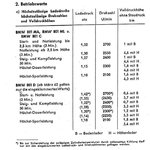Glider
Captain
Glider the speed limit is an other thing to actual combat dive performances, so a few second of initial advantage that also the much best LF IX, "the Me.109 can leave the Spitfire without any difficulty" Spitfire LF.IX vrs. Me.109G Tactical Trials.
Also the altitudes where they fightning are facts
Be Fair In posting 53 I did say the following
These are significant differences. However it should be noted that air tests showed that the 109 held the initial advantage in dive speed and in combat that can be a priceless advantage if cover is around, or just buy a few seconds of time.
And in posting 44 I also said
and the Spit had eaten away at most of the advantage the 109 traditionally had over the Spit in the dive, apart from a small initial advantage,
I have never tried to deny that the 109 had an initial advantage and I am aware that dive speeds are not everything. That said, they also cannot be ignored and if the 109 doesn't find cover in a cloud or in the support of other fighters then continuing the dive will allow the Spitfire to catch up.
To sum up, I can only repeat that in my personal view the SPit IX is overall a better fighter, note overall not all the time for the following reasons
At altitude the Spit IX clearly has an advantage this view supported by the performance charts and more importantly by the views of a senior experienced German pilot who fought the Spitfire.
At any altitude the Spit IX has the advantage in agility supported by countless combat reports, comparative flight tests and the views of pilots of all nations inculding German pilots
In a dive I don't have problem calling it a draw as the 109 has the advantage in the initial stages and SPit if the dive continues for any length of time.
In a climb until the different boost systems came on line for the Me 109 all the test reports and charts contained on the web site I gave the link for give the advantage to the Spit IX
You are of course free to have your own views but I have at least supported my reasoning and I am not insisting that you agree with me. I would be interested in seeing how you support your view, but only interested not insisting that you do so.
Last edited:

